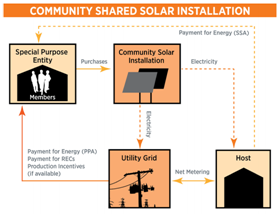Shared Renewables
Many links exit the EPA site Exit
What are Shared Renewables?
Shared Renewables, also known as community renewables, is an emerging procurement model allowing multiple customers to buy, lease, or subscribe to a portion of a shared green power system that is usually located away from their home or business. The model is especially appealing to customers whose on-site resource potential is limited, who rent, or who are otherwise unable or unwilling to install a renewable energy generator on their residences or commercial buildings.
Community solar, sometimes referred to as a solar garden, is currently the most popular form of shared renewables, with over 101 projects nationwide.1 According to a 2015 study by the National Renewable Energy Laboratory (NREL), over 50% of Americans who would like to use solar energy are unable to install a rooftop solar array.2 Shared renewable systems can enable those customers to purchase green power through an innovative supply option.
Shared Renewables legislation, specifically community solar legislation, has been enacted in 16 states (CA, CO, CT, DE, HI, IL, MA, MD, ME, MN, NC, NH, NY, OR, VT, and WA) and the District of Columbia,3 and there are active campaigns to enact shared renewables legislation in New Mexico, Nevada, and Virginia.
How do Shared Renewables work?
In this procurement model, customers can choose to buy, lease, or subscribe to a portion of a shared renewable generator, which may be community-owned or owned by a third party.
 With most shared renewables systems, the electricity is delivered to the grid, and customers receive credits on their utility electricity bill based on the amount of energy produced by their portion of the shared renewable system. This setup is called virtual net metering. Additionally, the customer may receive the renewable energy certificates (RECs) generated by their portion of the shared renewable system, and they can substantiate green power use if that is the case.
With most shared renewables systems, the electricity is delivered to the grid, and customers receive credits on their utility electricity bill based on the amount of energy produced by their portion of the shared renewable system. This setup is called virtual net metering. Additionally, the customer may receive the renewable energy certificates (RECs) generated by their portion of the shared renewable system, and they can substantiate green power use if that is the case.
However, this is not always the case, Some states preclude consumers from getting the RECs from these shared renewables and require the RECs to be sold to the utlities or load serving entitites.
This example figure is from NREL, 2012: http://www.nrel.gov/docs/fy12osti/54570.pdf (PDF) (76 pp, 2.9MB)
Shared renewables can be structured in various ways, including:
- Utility-sponsored model - utility owns and/or operates a shared renewables project that is open to voluntary ratepayer participation.
- Special Purpose Entity (SPE) Model - individual investors join in a business enterprise to form a new entity that develops a shared renewables project.
- Non-Profit "Buy a Brick" Model - donors contribute to a shared renewables installation owned by a charitable non-profit corporation.
Advantages and Challenges of Shared Renewables
Advantages:
- Available to customers who are not be able to or do not want to host an on-site renewable energy system
- Rapidly growing market means expanding opportunities to participate
- Easy enrollment/cancellation with subscription model
- Shared transaction costs often make this procurement option less expensive than self-supply
- Economies of scale enable cost-effective construction of a renewable energy system at a site with optimal renewable resource availability
- Customers are generally not responsible for maintenance and upkeep
Challenges:
- Shared renewables programs commonly do not convey RECs to participants, which precludes participants from making any renewable energy use claims.
- Less visible commitment to renewables than onsite self-supply
- Customers may not be able to make green power use claims
- Enabling legislation is not available in all states
What are some organizations that are using Shared Renewables?
Additional Resources:
- Map of states with Shared Renewables-enabling legislation: http://sharedrenewables.org/community-energy-projects/
- Non-profit resource hub about community solar, developed in partnership with the U.S. DOE's SunShot initiative. Includes a list of current community solar projects: https://www.communitysolarhub.com/
- NREL, 2015, "Shared Solar: Current Landscape, Market Potential, and the Impact of Federal Securities Regulation: https://www.nrel.gov/docs/fy15osti/63892.pdf (PDF)(81 pp, 7.2MB)
- NREL, 2012, "A Guide to Community Shared Solar:" https://www.nrel.gov/docs/fy12osti/54570.pdf (PDF)(81 pp, 7.2MB)
- Interstate Renewable Energy Council's information page: http://www.irecusa.org/regulatory-reform/shared-renewables/
- IREC's National Shared Renewables Scorecard: https://sharedrenewablesscorecard.org/
- Solar Energy Industries Association information page: https://www.seia.org/initiatives/community-solar
- The National Conference of State Legislatures' analysis of various states' policies: http://www.ncsl.org/research/energy/state-policies-for-shared-renewable-energy.aspx
